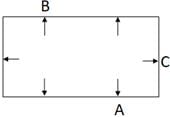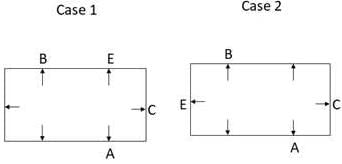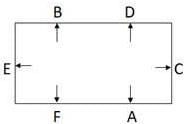CLAT Exam > CLAT Questions > Direction: Study the following data carefully...
Start Learning for Free
Direction: Study the following data carefully and answer the questions accordingly.
There are six people A, B, C, D, E, and F, seating around a rectangular table facing outwards. Four of them are seating at the longer sides (two people on each of the longer side) and remaining are seating at the shorter sides (one person on each of the shorter side). D and E are not immediate neighbors. A is sitting diagonally opposite to B. F and D sit diagonally opposite to each other. B is sitting second to the left of C, who is sitting at the shorter side of the table. E is sitting two places away from A.
There are six people A, B, C, D, E, and F, seating around a rectangular table facing outwards. Four of them are seating at the longer sides (two people on each of the longer side) and remaining are seating at the shorter sides (one person on each of the shorter side). D and E are not immediate neighbors. A is sitting diagonally opposite to B. F and D sit diagonally opposite to each other. B is sitting second to the left of C, who is sitting at the shorter side of the table. E is sitting two places away from A.
Q. Who among the following are the immediate neighbors of E?
- a)D, A
- b)C, F
- c)B, A
- d)F, B
Correct answer is option 'D'. Can you explain this answer?
Verified Answer
Direction: Study the following data carefully and answer the questions...
1) B is sitting second to the left of C, who is sitting at the shorter side of the table.

3) E is sitting two places away from A.

4) F and D sit diagonally opposite to each other.
(Here, case 1 will be eliminated and we will continue with case 2)
5) D and E are not immediate neighbors.

Therefore, option (d) is the correct answer.

3) E is sitting two places away from A.

4) F and D sit diagonally opposite to each other.
(Here, case 1 will be eliminated and we will continue with case 2)
5) D and E are not immediate neighbors.

Therefore, option (d) is the correct answer.

|
Explore Courses for CLAT exam
|

|
Direction: Study the following data carefully and answer the questions accordingly.There are six people A, B, C, D, E, and F, seating around a rectangular table facing outwards. Four of them are seating at the longer sides (two people on each of the longer side) and remaining are seating at the shorter sides (one person on each of the shorter side). D and E are not immediate neighbors. A is sitting diagonally opposite to B. F and D sit diagonally opposite to each other. B is sitting second to the left of C, who is sitting at the shorter side of the table. E is sitting two places away from A.Q.Who among the following are the immediate neighbors of E?a)D, Ab)C, Fc)B, Ad)F, BCorrect answer is option 'D'. Can you explain this answer?
Question Description
Direction: Study the following data carefully and answer the questions accordingly.There are six people A, B, C, D, E, and F, seating around a rectangular table facing outwards. Four of them are seating at the longer sides (two people on each of the longer side) and remaining are seating at the shorter sides (one person on each of the shorter side). D and E are not immediate neighbors. A is sitting diagonally opposite to B. F and D sit diagonally opposite to each other. B is sitting second to the left of C, who is sitting at the shorter side of the table. E is sitting two places away from A.Q.Who among the following are the immediate neighbors of E?a)D, Ab)C, Fc)B, Ad)F, BCorrect answer is option 'D'. Can you explain this answer? for CLAT 2025 is part of CLAT preparation. The Question and answers have been prepared according to the CLAT exam syllabus. Information about Direction: Study the following data carefully and answer the questions accordingly.There are six people A, B, C, D, E, and F, seating around a rectangular table facing outwards. Four of them are seating at the longer sides (two people on each of the longer side) and remaining are seating at the shorter sides (one person on each of the shorter side). D and E are not immediate neighbors. A is sitting diagonally opposite to B. F and D sit diagonally opposite to each other. B is sitting second to the left of C, who is sitting at the shorter side of the table. E is sitting two places away from A.Q.Who among the following are the immediate neighbors of E?a)D, Ab)C, Fc)B, Ad)F, BCorrect answer is option 'D'. Can you explain this answer? covers all topics & solutions for CLAT 2025 Exam. Find important definitions, questions, meanings, examples, exercises and tests below for Direction: Study the following data carefully and answer the questions accordingly.There are six people A, B, C, D, E, and F, seating around a rectangular table facing outwards. Four of them are seating at the longer sides (two people on each of the longer side) and remaining are seating at the shorter sides (one person on each of the shorter side). D and E are not immediate neighbors. A is sitting diagonally opposite to B. F and D sit diagonally opposite to each other. B is sitting second to the left of C, who is sitting at the shorter side of the table. E is sitting two places away from A.Q.Who among the following are the immediate neighbors of E?a)D, Ab)C, Fc)B, Ad)F, BCorrect answer is option 'D'. Can you explain this answer?.
Direction: Study the following data carefully and answer the questions accordingly.There are six people A, B, C, D, E, and F, seating around a rectangular table facing outwards. Four of them are seating at the longer sides (two people on each of the longer side) and remaining are seating at the shorter sides (one person on each of the shorter side). D and E are not immediate neighbors. A is sitting diagonally opposite to B. F and D sit diagonally opposite to each other. B is sitting second to the left of C, who is sitting at the shorter side of the table. E is sitting two places away from A.Q.Who among the following are the immediate neighbors of E?a)D, Ab)C, Fc)B, Ad)F, BCorrect answer is option 'D'. Can you explain this answer? for CLAT 2025 is part of CLAT preparation. The Question and answers have been prepared according to the CLAT exam syllabus. Information about Direction: Study the following data carefully and answer the questions accordingly.There are six people A, B, C, D, E, and F, seating around a rectangular table facing outwards. Four of them are seating at the longer sides (two people on each of the longer side) and remaining are seating at the shorter sides (one person on each of the shorter side). D and E are not immediate neighbors. A is sitting diagonally opposite to B. F and D sit diagonally opposite to each other. B is sitting second to the left of C, who is sitting at the shorter side of the table. E is sitting two places away from A.Q.Who among the following are the immediate neighbors of E?a)D, Ab)C, Fc)B, Ad)F, BCorrect answer is option 'D'. Can you explain this answer? covers all topics & solutions for CLAT 2025 Exam. Find important definitions, questions, meanings, examples, exercises and tests below for Direction: Study the following data carefully and answer the questions accordingly.There are six people A, B, C, D, E, and F, seating around a rectangular table facing outwards. Four of them are seating at the longer sides (two people on each of the longer side) and remaining are seating at the shorter sides (one person on each of the shorter side). D and E are not immediate neighbors. A is sitting diagonally opposite to B. F and D sit diagonally opposite to each other. B is sitting second to the left of C, who is sitting at the shorter side of the table. E is sitting two places away from A.Q.Who among the following are the immediate neighbors of E?a)D, Ab)C, Fc)B, Ad)F, BCorrect answer is option 'D'. Can you explain this answer?.
Solutions for Direction: Study the following data carefully and answer the questions accordingly.There are six people A, B, C, D, E, and F, seating around a rectangular table facing outwards. Four of them are seating at the longer sides (two people on each of the longer side) and remaining are seating at the shorter sides (one person on each of the shorter side). D and E are not immediate neighbors. A is sitting diagonally opposite to B. F and D sit diagonally opposite to each other. B is sitting second to the left of C, who is sitting at the shorter side of the table. E is sitting two places away from A.Q.Who among the following are the immediate neighbors of E?a)D, Ab)C, Fc)B, Ad)F, BCorrect answer is option 'D'. Can you explain this answer? in English & in Hindi are available as part of our courses for CLAT.
Download more important topics, notes, lectures and mock test series for CLAT Exam by signing up for free.
Here you can find the meaning of Direction: Study the following data carefully and answer the questions accordingly.There are six people A, B, C, D, E, and F, seating around a rectangular table facing outwards. Four of them are seating at the longer sides (two people on each of the longer side) and remaining are seating at the shorter sides (one person on each of the shorter side). D and E are not immediate neighbors. A is sitting diagonally opposite to B. F and D sit diagonally opposite to each other. B is sitting second to the left of C, who is sitting at the shorter side of the table. E is sitting two places away from A.Q.Who among the following are the immediate neighbors of E?a)D, Ab)C, Fc)B, Ad)F, BCorrect answer is option 'D'. Can you explain this answer? defined & explained in the simplest way possible. Besides giving the explanation of
Direction: Study the following data carefully and answer the questions accordingly.There are six people A, B, C, D, E, and F, seating around a rectangular table facing outwards. Four of them are seating at the longer sides (two people on each of the longer side) and remaining are seating at the shorter sides (one person on each of the shorter side). D and E are not immediate neighbors. A is sitting diagonally opposite to B. F and D sit diagonally opposite to each other. B is sitting second to the left of C, who is sitting at the shorter side of the table. E is sitting two places away from A.Q.Who among the following are the immediate neighbors of E?a)D, Ab)C, Fc)B, Ad)F, BCorrect answer is option 'D'. Can you explain this answer?, a detailed solution for Direction: Study the following data carefully and answer the questions accordingly.There are six people A, B, C, D, E, and F, seating around a rectangular table facing outwards. Four of them are seating at the longer sides (two people on each of the longer side) and remaining are seating at the shorter sides (one person on each of the shorter side). D and E are not immediate neighbors. A is sitting diagonally opposite to B. F and D sit diagonally opposite to each other. B is sitting second to the left of C, who is sitting at the shorter side of the table. E is sitting two places away from A.Q.Who among the following are the immediate neighbors of E?a)D, Ab)C, Fc)B, Ad)F, BCorrect answer is option 'D'. Can you explain this answer? has been provided alongside types of Direction: Study the following data carefully and answer the questions accordingly.There are six people A, B, C, D, E, and F, seating around a rectangular table facing outwards. Four of them are seating at the longer sides (two people on each of the longer side) and remaining are seating at the shorter sides (one person on each of the shorter side). D and E are not immediate neighbors. A is sitting diagonally opposite to B. F and D sit diagonally opposite to each other. B is sitting second to the left of C, who is sitting at the shorter side of the table. E is sitting two places away from A.Q.Who among the following are the immediate neighbors of E?a)D, Ab)C, Fc)B, Ad)F, BCorrect answer is option 'D'. Can you explain this answer? theory, EduRev gives you an
ample number of questions to practice Direction: Study the following data carefully and answer the questions accordingly.There are six people A, B, C, D, E, and F, seating around a rectangular table facing outwards. Four of them are seating at the longer sides (two people on each of the longer side) and remaining are seating at the shorter sides (one person on each of the shorter side). D and E are not immediate neighbors. A is sitting diagonally opposite to B. F and D sit diagonally opposite to each other. B is sitting second to the left of C, who is sitting at the shorter side of the table. E is sitting two places away from A.Q.Who among the following are the immediate neighbors of E?a)D, Ab)C, Fc)B, Ad)F, BCorrect answer is option 'D'. Can you explain this answer? tests, examples and also practice CLAT tests.

|
Explore Courses for CLAT exam
|

|
Signup for Free!
Signup to see your scores go up within 7 days! Learn & Practice with 1000+ FREE Notes, Videos & Tests.
























